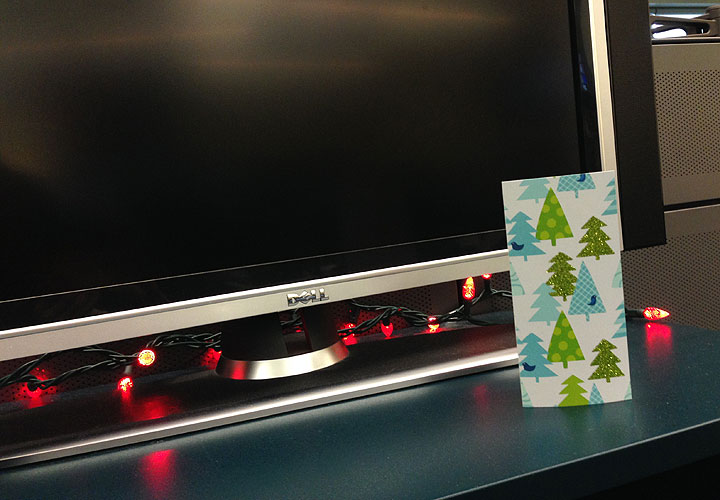TORONTO – Is 2014 the year Christmas cards officially died? While some traditionalists continue to send annual holiday cards, the practice – which began some 170 years ago – continues to decline as well-wishers go digital.

According to Canada Post, lettermail has declined steadily for the past six years. The crown corporation doesn’t track greeting cards specifically, but said volumes of lettermail (which includes cards) saw declines of 5.1 per cent (or 175 million pieces) in the first three quarters of 2014 compared to the same period in 2013.
“Over Christmas, the decline in letter mail continues — despite some peaks…likely due to Christmas cards and letters,” said Canada Post’s Daria Hill.
Around the home and office, there is a noticeable lack of cards gracing desks and mantels. “Last year, I had 20 cards on the fridge, this year there’s only two,” said Hill.
Good intentions
One thing adding to the decline of traditional greeting cards being sent out may very well be us. While we may buy cards fully intending to send them to our friends and family, the holidays come and go — the cards did not.
A 2011 study conducted by Canada Post found that one in five Canadians admitted that they bought holiday cards, meant to send them out, but never got around to it. Nine out of 10 young Canadians said they prefer holiday cards in the mail, but only 30 per cent actually sent them out.
UNICEF Canada hasn’t seen a decline in the sales of their traditional holiday cards, the proceeds of which fund programs that help child survival globally, including reducing the child mortality rate and expanding nutrition programs.
The charity’s history may have something to do with the fact its card sales haven’t declined. “We have an enormously long history in greeting cards, so it could be loyalty,” said Sharon Avery, UNICEF Canada’s chief development officer.
Over the last five years, UNICEF has transitioned to a licensing model where Hallmark now produces the holiday cards. The move means costs that the charity used to carry for producing the cards is cut. It also means the card can reach many more people, being sold in Hallmark and other retail locations, rather than being sold by individual volunteers around the holidays.
Because of the new model, Avery isn’t expecting to see a decline in sales anytime soon. The strength of the card industry in Canada, the U.S. and the U.K. is what makes these countries key markets for UNICEF’s card program. “Cards at the end of the day are about connecting people…we still seek that personal gesture,” said Avery.
“Just about everybody loves to get a greeting card because it says to the receiver: ‘You’re really important to me. I went to extra effort. I didn’t email or phone you. I came in person with my card or I put it in the mail,” said Joanne McNeish, assistant professor of marketing at the Ted Rogers School of Management at Ryerson University.
“I think what we forget in the e-world is that e-everything is only our visual sense, our sight, whereas tangible things – books and cards, everything paper – (involves) more senses,” said McNeish.
“Senses are actually the way as people we get information, or it’s the way we feel or are connected to emotions. Around this time of year, where it’s kind of an emotional time anyway, we as humans want to share in that, give that emotion and get that emotion back. And we do that with physical things.”
Let’s get digital
But good intentions aside, fewer and fewer letters and cards are being mailed out every year. Shifting preferences toward digital cards is leading the decline.
“Volumes in Transaction Mail, Canada Post’s core business, continued to fall this year as mailers and consumers turn to digital alternatives,” said Hill.
An IBISWorld report published earlier this year found that electronic greeting cards continue to squeeze traditional card companies. “Consumers’ growing use of e-cards, or electronic greeting cards, has constrained demand for traditional greeting cards and postcards,” said IBISWorld industry analyst Sarah Turk.
Because of these constraints, companies such as Hallmark and American Greetings have introduced e-cards and digital greetings, some with a subscription fee.
IBISWorld also reported that our increased access to broadband and mobile Internet is also fueling the rapidly expanding e-card industry — e-cards are simply more convenient than heading to a brick-and-mortar store.
Customization and convenience is leading to booming business. E-commerce company Paperless Post, which allows users to customize and send paper cards, e-cards and invitations, said the delivery of e-cards peaks during the holiday season. “December 23 is the day that the most online cards get sent out all year,” said a spokesperson for the company. Last holiday season, Paperless Post users send out more than 11 million cards and invitations to 188 countries in orders ranging from $0 to $3,000 in price.
With a file from The Canadian Press





Comments